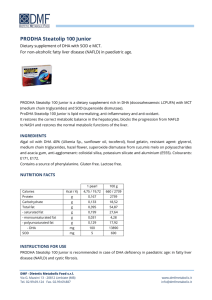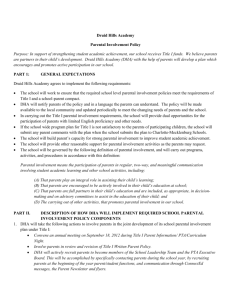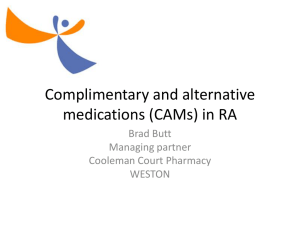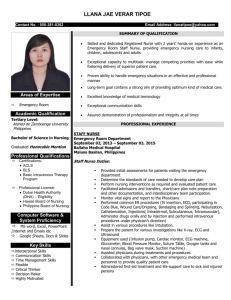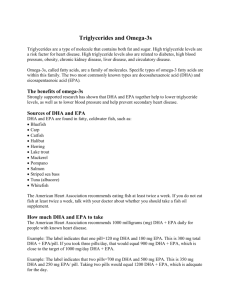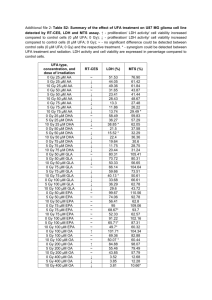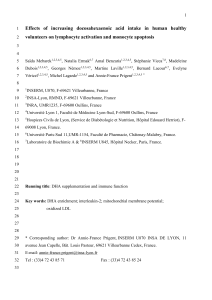DHA ASH (HD) Briefing
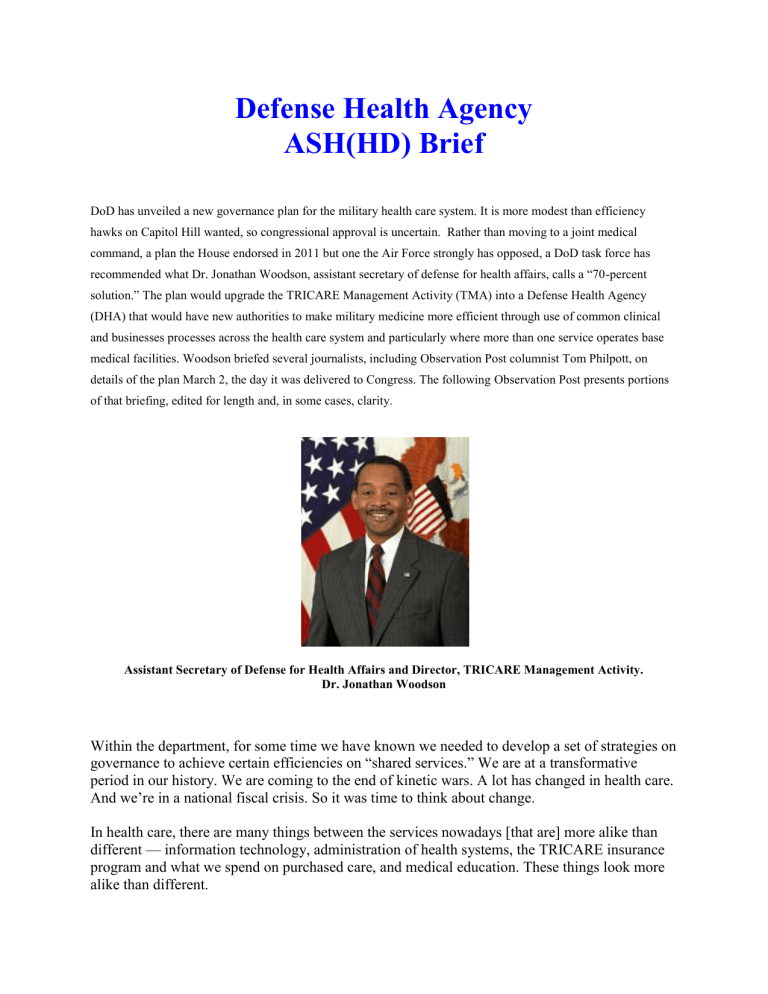
Defense Health Agency
ASH(HD) Brief
DoD has unveiled a new governance plan for the military health care system. It is more modest than efficiency hawks on Capitol Hill wanted, so congressional approval is uncertain. Rather than moving to a joint medical command, a plan the House endorsed in 2011 but one the Air Force strongly has opposed, a DoD task force has recommended what Dr. Jonathan Woodson, assistant secretary of defense for health affairs, calls a “70-percent solution.” The plan would upgrade the TRICARE Management Activity (TMA) into a Defense Health Agency
(DHA) that would have new authorities to make military medicine more efficient through use of common clinical and businesses processes across the health care system and particularly where more than one service operates base medical facilities. Woodson briefed several journalists, including Observation Post columnist Tom Philpott, on details of the plan March 2, the day it was delivered to Congress. The following Observation Post presents portions of that briefing, edited for length and, in some cases, clarity.
Assistant Secretary of Defense for Health Affairs and Director, TRICARE Management Activity.
Dr. Jonathan Woodson
Within the department, for some time we have known we needed to develop a set of strategies on governance to achieve certain efficiencies on “shared services.” We are at a transformative period in our history. We are coming to the end of kinetic wars. A lot has changed in health care.
And we’re in a national fiscal crisis. So it was time to think about change.
In health care, there are many things between the services nowadays [that are] more alike than different — information technology, administration of health systems, the TRICARE insurance program and what we spend on purchased care, and medical education. These things look more alike than different.
The strengths of the services happen to be in their operational efforts. We want to protect Navy capabilities afloat in delivery of medicine, the Air Force and aerial platforms, the Army and land-based platforms. So the idea is not to throw the baby out with the bathwater but to design a system that creates [the] best in health care quality [and] access [while preserving] the unique features that individual service cultures bring to the fight.
The decision to construct a [DHA] is an important step in that path. You have heard about the issue of the unified medical command. Let me just say the [DHA] will be an important pillar of any unified health command if that indeed were considered down the line. The DHA allows us to get maximum effort and efficiency of shared services and creates the 70-percent solution without having to tear the services apart in reorganizing what would be a cumbersome and probably more expensive [command] at a time when we’re fighting kinetic wars.
The department feels DHA is essential to making the military health care system stronger, more efficient, and better for service to the beneficiaries.
Question - Several years back, organizations like the Defense Business Board recommended moving to a unified medical command. The Air Force opposed it; the Navy and Army were on board. When that idea was rejected, the services were going to do the next best thing and combine functions like purchasing. Did that not happen? Is that why this is required now?
Dating back even 50 years, we’ve been slowly moving to a more unified approach. It’s important to note the 70-percent solution proposed here represents the important things in delivering quality care that is efficient and cost-effective.
Years ago when it was simpler to deliver care, the return on investment of establishing a unified medical command was clearly not there. In 2012, when so much of technology is applied to delivery of care, duplication of many things in the various services no longer makes the return on investment the same. We have to make sure we have a shared vision, shared acquisition structure, [and] shared logistics structure to be good stewards of taxpayers’ dollars.
Question - Were earlier efforts false starts, and is this more of a commitment?
Over time, we did see commitments perhaps to [streamline] medical logistics. They did comprehensive work on collaborating on graduate medical education and some training programs. But we’re at a tipping point after 10 years of war where we fought as a joint medical service. It’s time to look more comprehensively at these issues.
[In 2011] we successfully opened the medical education training campus in San Antonio, which has been an enormous success. Members from every service are training right next to each other to be superb medics or pharmacists. We looked at medical logistics [and] at establishing common clinic business processes. All of this just moved us more and more to the need to create a governance structure that allows us to drive these issues.
The other thing I want to impress on you is that health care has become more expensive, including the technology and the emphasis on specialties. Most of our money is spent in the direct-care and purchased-care system. Essentially, we’re paying for two types of health care systems. So we need a governance structure that can drive a set of business plans that optimize taxpayers’ dollars.
One major feature of this governing structure will be the ability to create joint multiservice market business plans to optimize investments we’re making into the direct-care system, even as we try to optimize what we pay for in the purchased-care environment. It’s about driving change in structure and creating efficiency in the administration process to make sure we spend those other dollars wisely.
Management activities only represent about 2 percent of our budget. So as we restructure management governance, we’ll be able to drive out maybe $50 million to $100 million per year in administrative waste.
But what we really will do is have an efficient decision-making process that will drive a cohesive collaborative strategy for the two buckets where all of the money is going — purchased-care contracts and the direct-care system.
Question - When the House Armed Services Committee placed in the defense bill last year a directive to create a unified medical command, it referred to a study done two or three years ago that found this alternative would produce the greatest amount in savings, almost a half billion dollars a year. If your primary goal is to be good stewards of tax dollars, why not go with the single-health-command structure?
It’s a good question. One of the metrics used in an earlier study by the naval analysis group was flawed. So the amount of money they envisioned saving, when comparing apples to apples, was probably not as great.
Also, many of the things folks have been talking about [to achieve savings] we have been slowly implementing, so some of the savings touted a few years ago have already been achieved. For example, there has been a joint-first approach to health information technology. Some strategies for medical research have more of a joint connection.
[Establishing the DHA] was the natural next step and provided the easiest reorganization without disrupting the services.
Question - But you agree it’s more cost-effective to go with a joint health command?
At this time, no. When you read the report to Congress, you’ll see an analysis of the size of headquarters staff you would stand up if you put a four-star command there. Depending on what you’re describing, the unified medical command could have 2,000 to 5,000 people at headquarters. So it’s not necessarily cheaper or a less bureaucratic structure.
I would point out that the joint-medical-command model proposed in the House version of the
National Defense Authorization Act had a DHA in it. So what we propose is a makes-sense way of achieving a majority of the efficiencies, and it doesn’t preclude us[from moving] into the next stage in the out-years.
Question - Can this argument be made: Why bother with moving to a DHA if you only save
$50 million against a $50 billion health care budget? Why move the chairs around?
Remember the reorganization has three focuses: One is create the DHA to give an administrative process to shared services. Another is to establish multiservice market business plan, a structure that allows you to develop and tackle processes and clinical plans that really drive savings. If we do this right, we can capture much more than $50 million.
If we have an administrative structure that allows the services to decide which platforms they want to establish, where they want the technology, without duplicating all of that, the savings can be enormous.
And then, if we’ve got a strategy that optimizes the patient flow and care into the direct care system and optimizes how much we buy in the purchased care sector, the savings can be enormous. The new administrative structure will allow us to collaboratively and effectively make these decisions.
Question - Can you explain multiservice market management and what it will do?
In a place like San Antonio, you’ve got both Air Force and Army medical facilities and a large beneficiary population. We are spending money to support the direct-care system and the purchased-care system with some individuals going, say, to the University of Texas for their care. Well, if we don’t have a collaborative strategy between the services to optimize use of military-owned facilities like Brooke Army Medical Center, they could sit empty. We are paying for those facilities even as we pay premium dollar in purchased care for individuals to go get care at the University of Texas.
What we need to do in these multiservice market areas is rapidly get agreement between services on incentives to ensure individuals optimize the direct-care system. It not only is an issue of managing cost and optimizing resources but also an issue of readiness. Our doctors, nurses, and medics will be called on when it’s time to go to war. They should be practicing their professions fully. So if hospitals are empty, it becomes an issue of readiness and waste and cost.
So we need to establish appropriate business plans in these multiservice markets that are collaborative and not at the whim of every new commander that comes along every two years.
That’s what a multiservice market business plan will do.
Question - What’s the third focus of the new governance plan?
We had to figure out what to do with the national capitol region. During the BRAC [baserealignment-and-closure] process, we stood up the Joint Task Force National Capitol Region
Medical (JTF CapMed). It was an understandable administrative vehicle for a complex multiservice market.
BRAC ended, and so we no longer needed BRAC functions to be part of JTF CapMed, but we still needed a governance structure for two joint entities: the new Walter Reed National Military
Medical Center [in Bethesda, Md.] and the Fort Belvoir [Va.] Community Hospital.
So the proposal now is just to downsize — or appropriately size — it to a directorate which will report to the [DHA].
That brings everything in line in terms of the multiservice markets.
Question - Under the DHA, would you be changing the name of the TMA in Falls Church,
Va., and then beefing it up with new authorities?
The [TMA] has evolved over the years but not necessarily with logical forethought. Originally, it was an insurance plan. Then there was this need to drive some collaborative effort on the support contracts and how they were administered, so that was added on. When health IT became so important, that was added.
Now the issue is to create an administrative structure that can develop appropriate business plans for all of these things. So the [DHA] will not just be TMA on steroids. It will be a functional, thoughtful redesign with the focus on activities common to the services.
Question - Now that you have reported to Congress, do you still need the Government
Accountability Office to verify your cost-savings figures?
GAO has 180 days from March 2 to review our report. It already has been looking at the whole issue of [military health care system] governance. Then Congress has 120 days after that to decide [whether DoD can implement its plan.]
Question - What would be the effect on Army, Navy, and Air Force medical commands, particularly the authority of the surgeons general? Do they lose certain authorities to the health agency?
My opinion is their authorities and influence are enhanced.
A lot in health care has changed. There is more common across the services than there are differences. But developing these business plans requires a significant amount of focus.
If you look back at studies that favor a combined medical command, there has always been a tension between the operational focus of the surgeon general and administrative focus of delivering garrison care or retiree care. Under the new plan, I think the position of the surgeons general is in exactly the right place. They can concentrate on the operational issues but at the same time are poised to be the best advocates for the development of garrison care. That other three-star officer [leading DHA] will now own some of these business processes, and they can
say, “Hey, you’re not doing it right!” Right now, they own it, but they own it in a silo. Their ability to tweak the system and to reduce inefficiencies, without authority to reach into other services, is very limited.
They are looking, I think, for easier opportunities to collaborate without an encumbering bureaucracy. … We can no longer afford to view defense health care spending as being funneled out to silos, which are not connected.
Question - How are surgeons general to handle operations in light of demands for care at home? For example, during the war more pharmacists were required in theater. As a result, more beneficiaries have prescriptions filled off-base to avoid delays on base. If a surgeon general says he needs the following support in theater, how does he work with the
DHA on resources?
You’ve hit the nail on the head. As we look back at 10 years of war and the operational requirements, without a coordinated strategy that reaches across services, we get a local solution to the long-term consequences of my orthopedist suddenly being gone. So send beneficiaries out to the private sector. And we know from our data that, once you send them out to the private sector, they don’t come back.
But if we’ve got business plans and we know what our operational requirements are, we can look across the services for all sorts of possibilities for solutions to maintaining our commitment to the beneficiaries for on-base care. If it’s an Army hospital, we could take a Navy orthopedist and backfill. We could take a reservist and put him in there. The DHA would develop the requirement and then go to the surgeons general and say, “Here, fill it.”
Question - When will all this happen?
We’ve given you the timeline for Congress, a total of about 300 days. We would hope to execute on the plan shortly after that. We want to make sure Congress understands what our intent is and why we think this is important and at this time. We are hopeful we will get the OK to go ahead.
[Source: MOAA Tom Philpott article 20 Mar 2012 ++]
